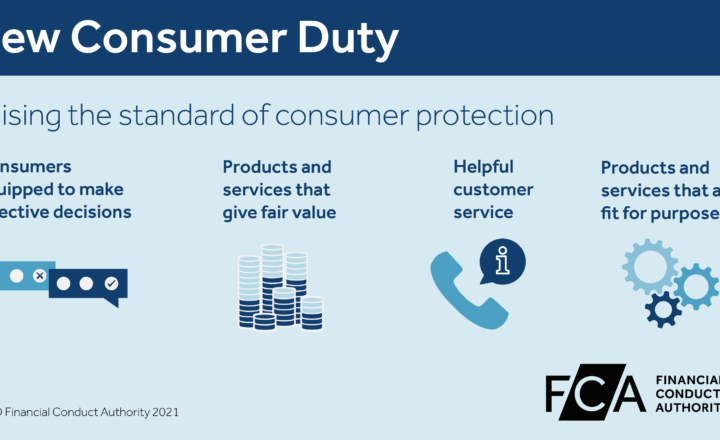Personas. You’ve probably heard of them and maybe you understand them, or maybe you don’t. That’s OK – these little chaps seem to receive a lot of attention and yet we are frequently asked by our clients what they actually are.
They are a key part of ensuring you stick to your user centred design principles. This post will hopefully give you a bit of an overview of what a persona is and isn’t, how we’ve used them and why you should too. There are also some suggestions for further reading at the end if you’d like to get your teeth sunk a little deeper into this topic.
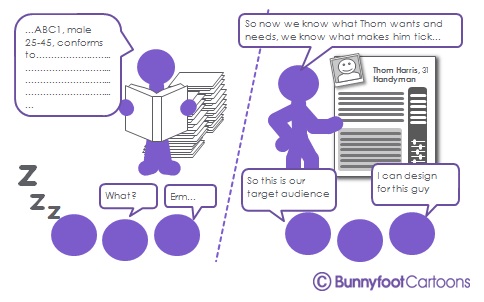
What are personas?
To the main point then and probably the question you’d most like answering: what are personas?
In essence, personas are simply short profiles of archetypal users. They will have a name, age, gender, probably a bit of a family or home context and, most importantly a set of motivations and goals for using whatever service is being designed for their use.
Take a moment to think of your Facebook profile.
That has a name, a picture and maybe a bit of a background on where you work and what you do. Most importantly, it also includes your status and wall posts which are likely to betray your expectations, frustrations, hopes, motivations and apprehensions about your daily life.
A persona is basically a bit like a Facebook profile for a representative, typical user, where all the status updates relate to the context within which the new website, service or product, is going to be used (e.g. their job, their home, their plans to book a holiday, etc).
What are they not?
Ah, now we get to the interesting stuff. We’ve come across lots of myths and misunderstandings about personas over the years – all of them reasonable assumptions but sadly missing the point (and thus the value) of personas.
The most important thing to state when discussing what personas are not is that personas are not made up.
For a persona to have any value in influencing and guiding the design process it is imperative that they are based on data collected about real users.
This data can come from a number of sources – interviews and observation sessions with existing and potential users or even carefully crafted surveys, user testing sessions and also the experience that project stakeholders have had with customers.
These experiences of real users are collected and collated with the intention of finding patterns of behaviour and/or motivation that can start to describe different “types” of user. Each type of user then goes on to form a persona – an entity with a name, age, context and the behaviours and motivations that define that particular user type.
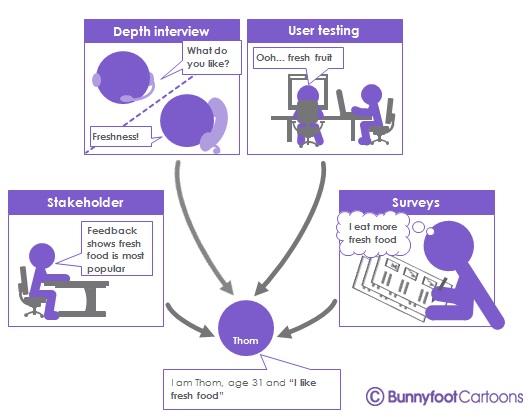
Another common misconception that needs addressing is that personas are not market segments with a name and photo.
Market segmentation is a valuable tool within the marketing profession for categorising a market by demographic and forecasting likelihood to buy and, therefore, the commercial viability of a proposed product or service.
Personas, on the other hand, help inform what it is that this proposed product or service should actually do, based on the recognised needs of the user.
Let’s try and put this within a real-world context: Imagine a high street store has conducted some research and discovered 30 million people in the UK might like a new mobile app to help them with food shopping.
You are no doubt encouraged that your idea is so popular however without knowing the context within which your potential users go about buying their food, how they struggle to buy fresh food and what problems they need a mobile app to solve. There is little to inform the design of this service to ensure that it is relevant to the users’ needs and, therefore, stands a chance of being adopted by those millions of eager beavers.
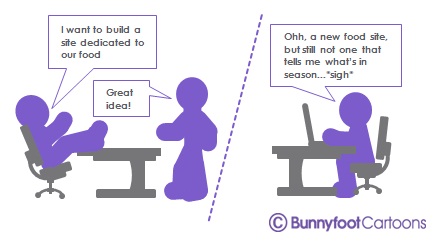
What are personas used for?
In essence, personas are used as a key focus in user centred design. But, in reality, they can go a lot deeper than that.
Involving key project stakeholders in the development of personas can have a hugely positive impact on the involvement of those stakeholders within the project. Helping to write the personas gives them an opportunity to share their experience and expertise and become engaged in the design process in a way that they can easily relate to. This is particularly beneficial when the project in question is internal to an organisation – for example the development of a company intranet – as engaging users throughout the design process can aid adoption of the new system by producing advocates for it within the target user group.
However, perhaps the most frequent use for personas is to help guide the design of a product, service or solution, keeping the needs of the target users at the forefront, and not the ideas of the designers and developers.
Having design teams refer to the needs, motivations, behaviours and constraints of agreed personas help ensure that content, interfaces and the like are designed to satisfy those users’ requirements. Moreover, referring to these personas can help overcome disputes within design teams or between stakeholders over particular design decisions. Rather than the dispute being focussed on the wants and the needs of the stakeholders, the design decision can be assessed against the needs of the persona – would making this decision be of benefit or detriment to “Thom”? If it makes Thom’s life better, keep it in. If it’s going to make Thom’s life harder it gets dropped.

What if we have more than one type of user?
When there are more than one types of user identified multiple personas can be created. Depending on what is suitable for the solution being designed (and on available resources), you might find that it is appropriate to build several interfaces or pieces of content, etc, to address the different needs of each persona.
Ideally, however, a primary persona would be selected – whose wants and needs are shared by most or all personas and are therefore always satisfied first. Just because Thom prefers fresh food, doesn’t mean you can’t have a dried food section to meet Sally’s needs, but the fresh food emphasis will be stronger.
Why you should use personas
Personas are fantastic tools to be used in the user centred design of any product, solution or service. They help to create cohesion within and between teams of designers and stakeholders and they help to keep the focus of design on the needs of real users which, in turn, helps to ensure that the product you design is relevant and has the best chance of success.
The key to successful personas really comes down to two things – for personas to be successful:
- They need to be realistic – based on real data from real users, gathered through real encounters such as interviews and observations.
- Everyone in the project team – from designers, users, managers – needs to buy in to them. Having their involvement in the creation of the persona from the beginning will really help with this and can go a long way to raising the credibility of the personas and its value as a reference point for making difficult business and design decisions.
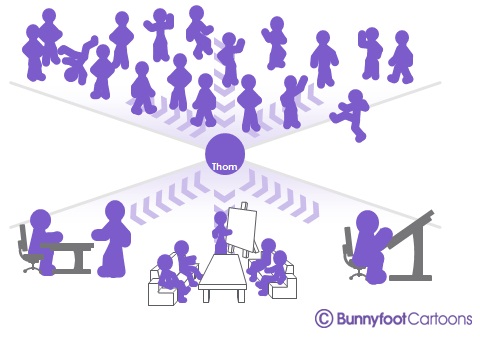
Want to know more?
If you’d like to know more about personas (and believe me, there is plenty more to be learned!) then why not get in touch with us – drop us an email (more@bunnyfoot.com).
- Training course: Customer/user research methods and practice
- Training course: Certified Practitioner in User Experience




